A bounty of buttery-sweet pears is one of the true delights of the fall and winter months. Although our own pear trees are still too young to be bearing fruit, our local area farmer’s markets are brimming with the first ripe heirloom pears of the season.
Occasionally we find something truly special and unique at the farmer’s markets. This weekend we were shopping at the farm stand of a farm that’s just up the road from us, when we spied some of the most phenomenal fresh pears we’ve ever seen!
These behemoths weighed in at almost 2 lbs. EACH!
The trees that produced these remarkable fruits are very old, and were on the land when the present owners purchased the property. Unfortunately, the name of this cultivar has since been lost to time. The trees are apparently quite aged, and past their prime in regards to production, but are still producing a few of these uniquely sized, perfectly pyriform fruits.
Needless to say, we couldn’t resist bringing a few of these pears home.
Based on their immense size, vintage of the trees, texture, and flavor, this pear variety sounds very similar to the heirloom ‘Uvedale’s St. Germaine’, also known as ‘Pound Pear’, although we’ll never truly know its identity.
I sampled a piece raw, to decide how best to prepare them, and this published description fit them perfectly:
“Uvedale’s St. Germain: Flesh white, hard, and a little gritty next the core, with an austere astringent juice, which renders it unfit for eating raw”.
Astringent and gritty was very much an understatement! It was honestly the worst pear I’ve ever had the displeasure of sampling. Disappointed, both with the flavor and texture, I questioned whether it was even fit for cooking. However, the quote goes on to say…
“but it is excellent for baking and stewing.”
Having grown up baking with sour and astringent cooking apples, including Bramley’s Seedling, I knew the texture, and flavor of pomme fruits often improves with cooking. Giving these pears the benefit of the doubt, I suspected I might have just the perfect recipe lurking in our archives.
A sweet Italian friend, many years ago, kindly parted with a copy of his favorite recipe for a simple, rustic, Italian ‘Torta di Pere’. I’ve now been making variations of this seasonal dessert for almost 20 years. Not quite a pie, or a tart, this recipe is similar in construction to a clafoutis, and almost as unique as the pears we found at the market, but any firm pear, such as a Bosc or Anjou, will work equally well. Many recipes have come and gone in our kitchen over the years, but this one remains one of our fall favorites.
Yield: 8 Servings
Ingredients
2 lbs Fresh Firm Pears
2 Large Eggs
1/4 Cup of Whole Milk
1 Cup Granulated Sugar
Pinch of salt
1 1/2 Cups Unbleached All-Purpose Flour
1/4 tsp Fresh Grated Nutmeg
1 Tsp Lemon Zest
2 Tablespoons Unsalted Butter, at room temperature
1/2 cup Amaretti (or Ginger Snap) Cookie Crumbs, preferably homemade
Optional
Powdered Confectioner’s Sugar, for dusting
Equipment
A 9-inch layer-cake pan
Directions
Preheat the oven to 350 F
Zest the lemon, and set the zest aside. Juice the lemon, and add the juice to a large bowl of cold water.
Peel and core the pears. Cut the pears into quarters, and slice each quarter crosswise into 1/4″ thick slices. Immediately immerse the slices in the lemon water prepared above to prevent the pears from browning.
In a large mixing bowl, beat eggs until pale yellow, 1-2 minutes. Whisk in the milk, sugar, and a pinch of salt, and continue beating. Mix the nutmeg, and a teaspoon of lemon zest into the flour, and add the flour mixture to the egg. Stir the batter until the flour is thoroughly incorporated.
Drain the sliced pears, and mix into the batter, coating the pears as evenly as possible.
Generously coat the bottom and sides of a straight-sided 9 inch layer cake pan (a non-stick pan is not necessary) with 1 Tablespoon of butter. Sprinkle the cookie crumbs over the pan. Turn to coat thoroughly, and evenly.
Once coated, turn the pan upside down, and tap it or shake it lightly to get rid of the excess crumbs.
Pour the batter with pears into the pan, leveling it off with the back of a spoon or a spatula.
Evenly dot the surface with the remaining tablespoon of butter.
Bake in the upper third of the preheated oven for 45-50 minutes, or until the batter is set, and lightly golden.
Invert the cake to remove it from the pan once cooled. Serve at room temperature, lightly dusted with confectioner’s sugar, or with a simple sweetened cream.
Note that the texture of this cake is unique, and is not your typical sponge-textured cake. It won’t rise in the oven, or change color significantly while baking.
The overall texture is difficult to describe, but falls somewhere between a very dense cheesecake, and a fresh fruit tart. It’s not an overly sweet dessert, but is packed with layers of beautiful fresh pears.
I’m delighted to say that despite being unpalatable raw, the heirloom pears baked beautifully, and it only took ONE pear to make this dessert, due to their enormous size.
The citrus brightened the pear flavor, and baking improved the texture tremendously.
Next time we visit the farmer’s market we may see if we can obtain some scion wood this winter from these old heirloom trees to graft next spring. The pears may not be good for eating out of hand, but they were very good baked, and clearly very well adapted to growing here along the Central Coast.


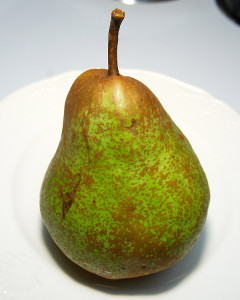

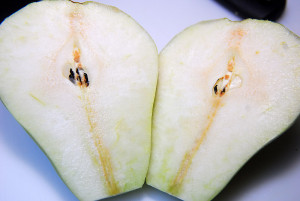
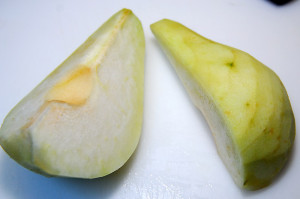
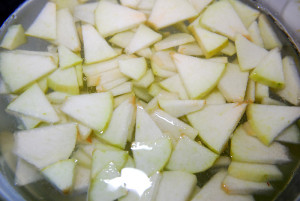
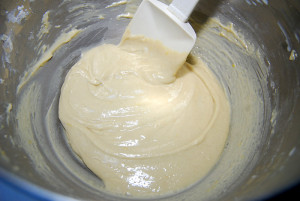


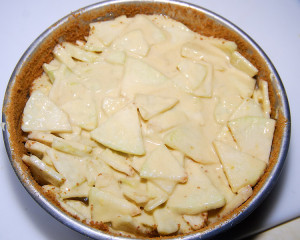
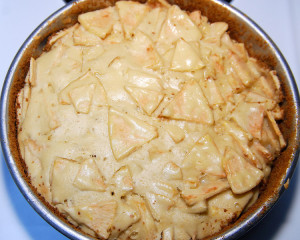











I so love pears and must try this … it sounds divine, Clare. Thank you 🙂
I love that it’s easy and quick to make…that, and it tastes good too! 😉
That look incredibly scrumptious!
For a simple dessert, it is quite flavorful, even with these pears that were less than ideal.
Guess what we have an abundance of? This couldn’t have come at a better time, Clare. Beautiful, not too sweet… thanks and will give it a go.
We had it last night, as the perfect end to a fall meal that started with a Butternut Squash Lasagne! Best part is, there’s leftovers! If you try it, let us know how it turns out with your pears!
Wow! Those Pears are whoppers. Very unusual recipe…if only our Pear trees would give us some fruit!
They were huge. It was very effective marketing. We could see these from a few stalls away. They just didn’t look like your average pears. I’d love to see the trees these came from, the branches must be huge to hold up these fruits! 😛
I love pears. They are supposed to be very healthy. I wonder if you could can these–pre-cooked probably. Your recipe sounds absolutely delicious. Special occasion good.
I’m sure these pears would can quite well. We did consider just simply poaching them in wine, but I hadn’t made this dessert yet this year, and I do love it! I’ve made slightly healthier versions too, using egg-substitute (don’t tell the chickens), skim or non-fat milk, and omitting the butter on the top, but it’s much better as written 😉
Boy does that look yummy. I never made it or even saw it made this way but will certainly try your recipe.
It is different. I often get a bit tongue-tied when asked to describe it to someone who has never tried it. It’s usually just easier to offer them a slice. Unfortunately, I can’t pass slices here around in the blogosphere, but it is simple to make 😛
Oh Clare, I should make sure that I’m not reading your recipe posts when I’ve just come home from work and feeling hungry! That sounds sooooo yummy! I’m going to save that one up to try over Christmas time (when I let myself off my low fat diet for a couple of weeks) so I can enjoy it in it’s full glory!
Although you can make a lower fat version of this torta, I think you’ll enjoy this version more. On the upside, you’ll get multiple servings of fruit per slice,and that’s a good thing! 😛
Those are some impressive pears. That torte looks absolutely scrumptious. I will most certainly be trying this!
The pears were monsters. It was strange only using one to make this recipe. I usually use 3 or 4! 😯
Clare yummy…I miss having a pear tree.
I wish these were our own pears. Hopefully in the next couple of years our trees will start to bear to fruit…but I’m getting very impatient! 😉
This sounds like the cakes I grew up with (in Germany) I will make your recipe for Thanksgiving. Thanks for sharing 🙂
Thanks for stopping by, I hope you enjoy it! Let us know how you like it 🙂
This looks really good. I can’t grow pears here. Just harvested some mangoes, sugar apple and chilies. I might grow a pear tree if I stay in a different climate. Just love its sweetness.
Oooh, Mangoes! I wonder if you could make similar with them? I’m fairly sure we can’t grow mangoes here…maybe we’ll stick to pears 😉
Oh my gosh, that looks delish!!! Those are the kinds of desserts that I really love the best – rustic and fruity. You are an angel for posting this!!! I’m going to try it!!
Sometimes I think I’m a disappointment to my girlfriends Put something fruity and something chocolately in front of me, and 90% of the time I’ll for the fruit! I swear they think there’s something wrong with me 😛
Wow, that is an amazing pear! I can’t believe it took just one pear to make that amazing looking dessert!
The dessert sounds delicious.
I have never, until now, been able to make this torta with just one pear. It was quite amazing, and yes, it WAS delicious 😉 Darn…now I’ll have to make another!
Yum! This looks amazingly delicious…perfect for a fall dessert! Thanks for sharing.
I’m tempted this fall, as it’s also apple season, to try making this with 2 lbs of fresh apples instead. It should work fine, but I can’t believe in 20 years I’ve never tried it with apples! I love fall…so many fabulous foods to choose from 🙂
for some reason, we didn’t get a pear one from our tree this year. this recipe makes me think it’s time to buy some for sure!!
I’ve yet to make anything with pears this year, but your recipe will see an end to that regret. This really does look so good. I think I’ll try it with Bosc pears! Love your site redesign btw, been meaning to tell you.